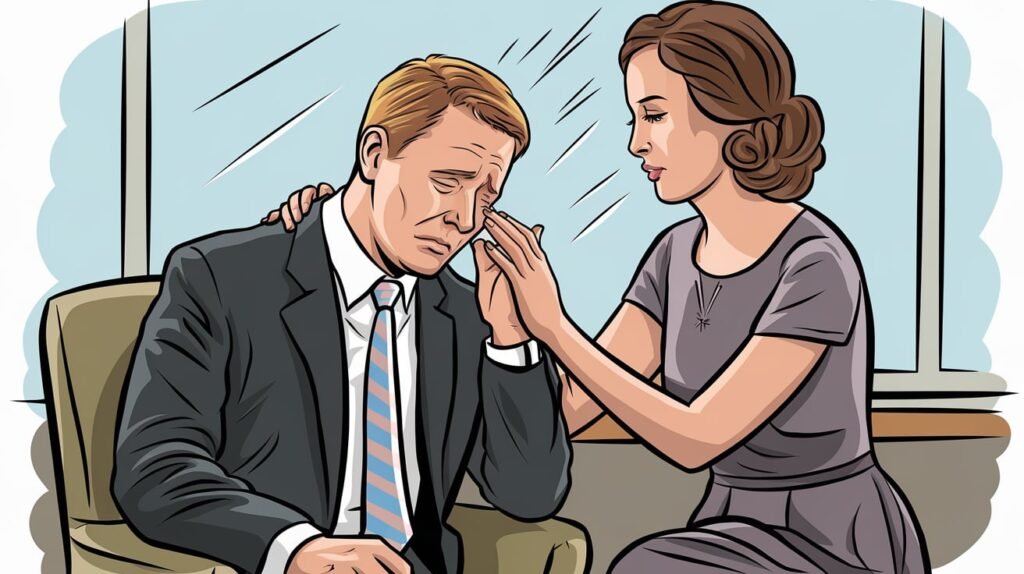In a world that’s constantly evolving, it’s surprising how certain outdated ideas continue to shape our lives. Traditional gender roles, those unspoken rules that dictate how men and women should behave, have been around for centuries. But have you ever stopped to consider their impact on our daily lives, relationships, and society as a whole?
This article delves into the fascinating world of gender expectations, exploring 11 eye-opening examples of traditional roles that might be doing more harm than good. From the boardroom to the bedroom, we’ll uncover how these age-old stereotypes can limit our potential, strain our relationships, and even affect our mental health.
So, buckle up and prepare to challenge your assumptions. Whether you’re a die-hard traditionalist or a proud progressive, this journey through the landscape of gender roles promises to be an enlightening ride. Let’s dive in and discover why it’s high time we break free from these outdated molds!
While some believe in soulmate sketches to find their perfect match, true compatibility often comes from breaking free of traditional gender expectations.
The Evolution of Gender Roles: A Brief History

Before we dive into the nitty-gritty of modern gender roles, let’s take a quick trip down memory lane. Understanding how these roles evolved can help us appreciate why they persist and why it’s crucial to challenge them.
Ancient Roots of Gender Division
Gender roles have deep historical roots, stretching back to ancient civilizations. In many early societies, the division of labor was often based on physical capabilities. Men, generally being physically stronger, were tasked with hunting and protection, while women took on gathering and child-rearing responsibilities.
This division, initially born out of practical necessity, gradually became ingrained in social norms and religious beliefs. Many ancient cultures developed complex systems of gender expectations that influenced everything from clothing choices to social status.
Industrial Revolution and Its Impact
The Industrial Revolution marked a significant shift in gender roles. As work moved from homes to factories, the separation between “work” and “home” became more pronounced. Men typically took on the role of the wage-earner, working in factories or offices, while women were often expected to manage the household and care for children.
This period saw the reinforcement of the “separate spheres” ideology, which posited that men and women had different, complementary roles in society. While this idea had existed before, the Industrial Revolution cemented it in ways that would influence gender expectations for generations to come.
“Asking meaningful questions to your boyfriend can help you understand him on a deeper level.”
The 20th Century Shake-up
The 20th century brought unprecedented changes to traditional gender roles. World Wars saw women entering the workforce en masse out of necessity, challenging the notion that a woman’s place was solely in the home. The rise of feminism and civil rights movements in the latter half of the century further questioned and challenged established gender norms.
Despite these significant shifts, many traditional gender roles persisted. The struggle for equality in the workplace, politics, and domestic life continued, setting the stage for the ongoing debates and changes we see today.
Understanding Traditional Gender Roles in Modern Society

Now that we’ve taken a whirlwind tour through history, let’s zoom in on how these traditional roles manifest in our modern world. Understanding these roles is the first step in recognizing their impact on our lives.
Defining Traditional Gender Roles
Traditional gender roles are a set of societal norms and expectations that dictate how individuals should behave based on their perceived gender. These roles often prescribe specific traits, responsibilities, and even career paths for men and women.
For instance, men are traditionally expected to be strong, assertive, and career-focused providers. Women, on the other hand, are often associated with nurturing, emotional expressiveness, and prioritizing family over career. These expectations can influence everything from career choices to personal relationships.
The Persistence of Stereotypes
Despite significant progress in gender equality, many of these traditional stereotypes persist. They’re reinforced through various channels – media, education, family dynamics, and even subtle social cues. The pervasiveness of these stereotypes can make them seem natural or inevitable, even when they limit individual potential and happiness.
It’s important to note that while these roles are called “traditional,” they’re not universal across all cultures or time periods. Different societies have had varying expectations for gender roles throughout history. This diversity highlights that gender roles are social constructs rather than biological imperatives.
Understanding these roles and their persistence sets the stage for our exploration of specific examples and their drawbacks. By recognizing these patterns, we can begin to challenge and reshape them for a more equitable future.
Just as zodiac marriage compatibility isn’t set in stone, neither are the roles we play in relationships and society.
11 Examples of Traditional Gender Roles and Their Surprising Drawbacks

Now, let’s dive into the heart of our discussion – 11 specific examples of traditional gender roles and the unexpected ways they can hold us back. Prepare to have your assumptions challenged!
1. The Breadwinner Burden
The expectation that men should be the primary or sole financial providers for their families is deeply ingrained in many cultures. While this role might seem advantageous at first glance, it carries significant drawbacks.
Firstly, it places immense pressure on men to succeed financially, often at the expense of their personal lives and mental health. The stress of being the sole provider can lead to burnout, anxiety, and depression.
Moreover, this expectation can limit men’s career choices, pushing them towards high-paying jobs they might not enjoy, rather than pursuing their passions. It can also create a sense of failure or inadequacy if they’re unable to meet this expectation.
Lastly, the breadwinner role can strain relationships, creating power imbalances and resentment within families. It can also deprive men of valuable time with their children and participation in family life.
2. The Homemaker Trap
On the flip side of the breadwinner coin is the traditional expectation that women should be primarily responsible for household management and childcare. This role, often undervalued and unpaid, comes with its own set of challenges.
Women in this role may feel isolated, underappreciated, and disconnected from the wider world. The lack of financial independence can leave them vulnerable in case of relationship breakdown or economic hardship.
Furthermore, the expectation of being a full-time homemaker can limit women’s career aspirations and personal growth. It can lead to a loss of skills and confidence, making it difficult to enter or re-enter the workforce later in life.
The homemaker role can also create an unequal division of labor in relationships, leading to resentment and relationship strain. It may reinforce the idea that domestic work is “women’s work,” discouraging men from fully participating in household responsibilities.
3. Emotional Expression Restrictions
Traditional gender roles often dictate how men and women should express (or suppress) their emotions. Men are typically expected to be stoic and unemotional, while women are allowed, and sometimes expected, to be more emotionally expressive.
For men, this expectation can lead to emotional repression, difficulty in seeking help for mental health issues, and challenges in forming deep, emotional connections with others. The phrase “boys don’t cry” encapsulates this harmful stereotype.
Women, conversely, may be labeled as “too emotional” or “hysterical” when expressing anger or assertiveness, emotions that are often more accepted in men. This can lead to their concerns being dismissed or not taken seriously in personal and professional settings.
These emotional expression restrictions can hinder personal growth, damage relationships, and contribute to mental health issues for both genders. They create barriers to authentic self-expression and emotional well-being.
4. Career Path Limitations
Traditional gender roles often influence career choices, steering men and women towards different professions based on stereotypical gender attributes. This can result in missed opportunities and unfulfilled potential for individuals of all genders.
For women, this often manifests as being discouraged from pursuing careers in STEM fields, leadership positions, or traditionally male-dominated industries. They may face skepticism about their competence or commitment in these fields.
Men, on the other hand, might feel pressured to avoid careers in education, nursing, or social work – fields often associated with feminine traits like nurturing and empathy. They may face social stigma or questioning of their masculinity for choosing these paths.
These limitations not only restrict individual choices but also perpetuate gender imbalances in various industries. They can lead to a lack of diversity in workplaces, stifling innovation and perpetuating gender-based wage gaps.
5. Parenting Role Divisions
Traditional gender roles often dictate that mothers should be the primary caregivers while fathers take on a more peripheral role in child-rearing. This division can have far-reaching consequences for families and society.
For mothers, the expectation of being the primary caregiver can lead to career sacrifices, mental health challenges like postpartum depression, and a sense of loss of personal identity. They may feel overwhelmed by the pressure to be the “perfect” mother.
Fathers, on the other hand, may feel excluded from important aspects of their children’s lives. They might miss out on bonding opportunities and the joys of active parenting. This can lead to feelings of disconnection from their families.
These rigid parenting roles can also reinforce gender stereotypes for the next generation, perpetuating the cycle. They limit the diversity of parenting styles and role models that children are exposed to.
6. Body Image Pressures
Traditional gender roles often come with specific expectations about physical appearance and body image. These pressures can have serious impacts on mental health and self-esteem for both men and women.
Women often face intense pressure to conform to unrealistic beauty standards – to be thin, youthful, and conventionally attractive. This can lead to body dissatisfaction, eating disorders, and a preoccupation with appearance over other qualities.
Men, while traditionally less scrutinized, increasingly face body image pressures too. The expectation to be muscular, tall, and physically strong can lead to unhealthy behaviors, including steroid use and excessive exercising.
These body image pressures not only affect individual well-being but also reinforce the harmful idea that a person’s worth is tied to their physical appearance. They can distract from personal growth and achievement in other areas of life.
7. Dating and Relationship Expectations
Traditional gender roles significantly influence dating and relationship dynamics, often in ways that can be limiting or even harmful. These expectations can create unnecessary pressure and restrict authentic connections.
Men are often expected to be the initiators in dating, to pay for dates, and to be sexually aggressive. This can lead to feelings of inadequacy if they don’t meet these expectations, and can also promote problematic behaviors like ignoring consent.
Women, on the other hand, are often expected to be passive recipients of romantic attention, to prioritize finding a partner, and to be the emotional caretakers in relationships. This can lead to a loss of agency and the suppression of their own needs and desires.
These rigid expectations can make it difficult for individuals to express their true selves in relationships. They can also reinforce harmful power dynamics and make it challenging to establish equal partnerships.
8. Educational Pursuit Biases
While access to education has improved for all genders in many parts of the world, traditional gender roles still influence educational choices and experiences. These biases can limit individual potential and perpetuate gender imbalances in various fields.
Girls and women may be discouraged from pursuing education in STEM fields, often due to stereotypes about their aptitude for these subjects. They might face skepticism from educators, peers, or even family members about their choices.
Boys and men, conversely, might be steered away from fields like education, nursing, or social work. They may face social pressure to pursue more “masculine” studies, regardless of their personal interests or aptitudes.
These biases not only limit individual choices but also contribute to gender gaps in various professional fields. They can lead to a lack of diversity in certain disciplines, stifling innovation and perpetuating gender stereotypes.
9. Leadership Style Stereotypes
Traditional gender roles often dictate expectations about leadership styles, creating barriers for individuals who don’t conform to these stereotypes. These expectations can limit opportunities and effectiveness in leadership positions.
Men are often expected to display authoritative, assertive leadership styles. This can lead to pressure to suppress empathy or collaborative tendencies, which are increasingly recognized as valuable leadership traits.
Women in leadership positions often face a double bind. If they display traditionally “masculine” leadership traits like assertiveness, they may be perceived as aggressive or unlikable. If they adopt a more collaborative style, they might be seen as weak or indecisive.
These stereotypes can lead to biased evaluations of leadership potential and performance. They can also discourage individuals from pursuing leadership roles if they feel they don’t fit the expected mold.
10. Hobby and Interest Segregation
Traditional gender roles often extend to hobbies and interests, creating unnecessary divisions and limiting personal exploration. This segregation can start in childhood and persist throughout life.
Certain hobbies are often labeled as “for boys” or “for girls.” For instance, sports and video games are often seen as male domains, while activities like cooking or crafting are often associated with women.
This segregation can lead individuals to miss out on potentially enjoyable and enriching experiences simply because they don’t align with gender expectations. It can also create social barriers, making it difficult for people to pursue interests that don’t conform to their gender’s stereotypes.
Moreover, this division reinforces broader gender stereotypes and can limit skill development. For example, boys discouraged from cooking might miss out on developing important life skills, while girls steered away from sports might miss opportunities for physical fitness and teamwork.
11. Financial Decision-Making Dynamics
Traditional gender roles often influence financial decision-making within relationships and families, potentially leading to imbalances and missed opportunities for financial growth and security.
In many traditional setups, men are expected to handle major financial decisions, investments, and long-term financial planning. This can place undue pressure on men and exclude women from gaining financial literacy and decision-making experience.
Women, on the other hand, might be relegated to day-to-day budgeting or smaller purchases. This can lead to a lack of involvement in crucial financial decisions that affect their future, particularly problematic if they outlive their male partners.
These dynamics can create power imbalances within relationships, limit financial education opportunities for both partners, and potentially lead to poor financial outcomes if one partner’s strengths in financial management are overlooked.
Like choosing from top 10 honeymoon destinations, selecting which gender roles to embrace or reject should be a personal journey of discovery.
Breaking Free: Challenging Traditional Gender Roles

Now that we’ve explored the drawbacks of traditional gender roles, let’s focus on how we can break free from these limiting stereotypes. It’s time to embrace a more flexible and equitable approach to gender in our society.
The Benefits of Gender Role Flexibility
Embracing flexibility in gender roles can lead to numerous benefits for individuals, relationships, and society as a whole. When we move beyond rigid expectations, we open up a world of possibilities.
Individuals can pursue their true passions and talents without the constraints of gendered expectations. This can lead to greater job satisfaction, personal fulfillment, and overall happiness. It allows for a more authentic expression of one’s identity and abilities.
Relationships can become more balanced and fulfilling when partners are free to divide responsibilities based on individual strengths and preferences rather than predetermined roles. This can lead to stronger partnerships and more satisfying family dynamics.
Society benefits from the diverse perspectives and talents that emerge when individuals are free to contribute in ways that align with their true selves, rather than conforming to narrow gender expectations.
Strategies for Overcoming Stereotypes
Challenging deeply ingrained gender roles isn’t always easy, but there are strategies we can employ to create change:
- Awareness and Education: The first step is recognizing these stereotypes in our own lives and educating ourselves and others about their impact.
- Challenging Assumptions: Question gender-based assumptions, both your own and those of others. Ask “why?” when faced with gendered expectations.
- Role Modeling: Be a living example of breaking free from traditional roles. Your actions can inspire others and normalize non-traditional choices.
- Supporting Others: Encourage and support individuals who choose non-traditional paths, whether in careers, relationships, or personal interests.
- Advocacy: Speak up against gender discrimination and support policies that promote gender equality in all areas of life.
Remember, change starts with individual actions. Every time we challenge a gender stereotype, we contribute to a more inclusive and equitable world.
The Future of Gender Roles: Embracing Equality and Individuality

As we look to the future, it’s clear that the rigid gender roles of the past are becoming increasingly outdated. The future lies in embracing equality and individuality, allowing each person to define their own path regardless of gender.
This shift towards equality doesn’t mean erasing all differences between genders. Instead, it’s about recognizing that these differences are individual rather than universal. It’s about creating a world where everyone has the freedom to express themselves authentically, pursue their passions, and contribute to society in meaningful ways.
The future of gender roles is one of fluidity and choice. It’s a future where a person’s gender doesn’t dictate their career path, their role in relationships, or their place in society. It’s a future where we value people for their unique qualities and contributions, not for how well they conform to traditional expectations.
As we move towards this future, we’ll likely see more balanced representation across all fields, more equitable relationships, and a society that’s richer for the diverse perspectives and talents of all its members.
Conclusion
Our journey through the landscape of traditional gender roles has revealed the hidden costs and limitations these expectations can impose on individuals and society. From the breadwinner burden to the homemaker trap, from career limitations to relationship dynamics, we’ve seen how these roles can restrict our potential and happiness.
But we’ve also seen the immense potential for positive change. By challenging these stereotypes, embracing flexibility, and supporting individual choices, we can create a more equitable and fulfilling world for everyone.
As we move forward, let’s commit to questioning outdated norms, supporting diversity, and creating spaces where everyone can thrive, regardless of gender. The future is not about rigid roles, but about embracing the unique potential of every individual. Let’s work together to build that future – a future of true equality and limitless possibilities.
FAQ
Q: Are traditional gender roles completely outdated?
A: While some aspects of traditional gender roles may still resonate with certain individuals, many are increasingly seen as limiting and outdated in modern society. The key is to allow individuals the freedom to choose which roles they want to embrace, rather than imposing them based on gender.
Q: How can I challenge gender roles in my own life?
A: Start by examining your own beliefs and behaviors. Question assumptions about what’s “appropriate” for different genders. Encourage and support others who break stereotypes. Educate yourself about gender issues and have open discussions with friends and family.
Q: Won’t abandoning traditional gender roles lead to confusion in society?
A: While change can initially create some uncertainty, embracing more flexible gender roles ultimately leads to a more inclusive and equitable society. It allows individuals to express their true selves and contribute their unique talents, benefiting everyone.
Q: How do gender roles affect children’s development?
A: Gender roles can significantly impact children’s self-perception, interests, and future aspirations. Exposing children to diverse role models and encouraging them to explore a wide range of activities, regardless of traditional gender associations, can foster more well-rounded development.
Q: Can challenging gender roles improve relationships?
A: Absolutely! When partners are free from rigid role expectations, they can divide responsibilities based on individual strengths and preferences. This can lead to more balanced, fulfilling relationships with better communication and mutual understanding.
Q: How do gender roles vary across different cultures?
A: Gender roles can vary significantly across cultures and even within subcultures of the same society. What’s considered “masculine” or “feminine” in one culture might be viewed differently in another. This diversity highlights that gender roles are socially constructed rather than biologically determined.
Q: How can workplaces become more gender-inclusive?
A: Workplaces can promote gender inclusivity by implementing policies that support work-life balance for all employees, ensuring equal pay and promotion opportunities, challenging biases in hiring and evaluation processes, and fostering a culture that values diverse leadership styles and perspectives.
Remember, challenging traditional gender roles is an ongoing process that requires patience, open-mindedness, and a willingness to learn and grow. By questioning these norms, we can create a more inclusive and equitable world for everyone.
